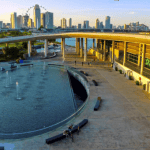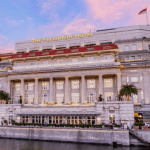Haw Par Villa is a fascinating cultural and historical landmark in Singapore that is known for its unique architecture, intricate statues and dioramas, and depiction of traditional Chinese beliefs and values. In this article, we will explore the origins of Haw Par Villa, the unique architecture and design of the villa, its cultural significance, and the evolution and restoration of this attraction over the years.
The Origins of Haw Par Villa
Haw Par Villa was founded by the Aw brothers, Aw Boon Haw and Aw Boon Par, in 1937. The two brothers were the owners of the renowned Tiger Balm brand, and they built the villa as a tribute to their father, who had created the famous pain-relief ointment.
The Founding Brothers: Aw Boon Haw and Aw Boon Par
Aw Boon Haw and Aw Boon Par were born in Myanmar but moved to Singapore in the early 20th century. They were known for their shrewd business acumen and marketing expertise, which contributed greatly to the success of the Tiger Balm brand.
Aside from their business ventures, the Aw brothers were also well-known philanthropists. They donated generously to various causes, including education and healthcare, and were deeply committed to improving the lives of those around them.
The Villa’s Early Years and Expansion
Initially, Haw Par Villa was a private garden that was only open to family and friends. However, over the years, it expanded to become a popular tourist attraction, featuring a range of colourful and intricate statues and dioramas that depicted traditional Chinese beliefs and values.
The brothers’ vision for the villa was to create a space where visitors could learn about Chinese culture and mythology in a fun and engaging way. They spared no expense in creating elaborate displays, such as the Ten Courts of Hell, which depicts the various punishments that await sinners in the afterlife.
As the villa became more popular, the Aw brothers continued to add new attractions and features to keep visitors coming back. They even built a zoo on the grounds, which housed a variety of exotic animals, including tigers and monkeys.
Today, Haw Par Villa remains a beloved Singaporean landmark, attracting visitors from all over the world. Its unique blend of art, culture, and entertainment continues to captivate and inspire, just as the Aw brothers intended.
The Unique Architecture and Design of Haw Par Villa

One of the most striking features of Haw Par Villa is its unique blend of Chinese and Western architecture and design. The villa features a range of traditional Chinese elements, such as pagodas and pavilions, as well as European-style sculptures and fountains.
The Blend of Chinese and Western Influences
The unique blend of Chinese and Western influences is a reflection of the Aw brothers’ cosmopolitan outlook. They were well-travelled and had a great appreciation for both Chinese and Western cultures. This is evident in the diverse range of statues and dioramas at the villa, which draws on both Chinese and Western themes and motifs.
The Significance of the Ten Courts of Hell
One of the most iconic features of Haw Par Villa is the Ten Courts of Hell, which is a representation of the Chinese Buddhist and Taoist concept of the afterlife. The Ten Courts of Hell features a series of elaborately designed dioramas that showcase the punishments and rewards that await souls in the afterlife, according to Chinese beliefs.
The Colorful and Intricate Statues and Dioramas
Aside from the Ten Courts of Hell, Haw Par Villa is also renowned for its colourful and intricate statues and dioramas that depict a range of Chinese myths, legends, and morality tales. Each statue and diorama is meticulously crafted and features intricate details that are a testament to the skill and craftsmanship of the artists who created them.
The Cultural Significance of Haw Par Villa

Haw Par Villa is not just a tourist attraction, but it’s also a valuable cultural landmark in Singapore. The villa is a reflection of Singapore’s multicultural heritage and the diverse range of beliefs and values that have contributed to the country’s rich cultural landscape.
The Depiction of Traditional Chinese Values and Beliefs
The statues and dioramas at Haw Par Villa offer a fascinating glimpse into traditional Chinese beliefs and values. Visitors can learn about the importance of virtues like filial piety, loyalty, and integrity, as well as the role of Buddhism, Taoism, and Confucianism in shaping Chinese culture.
The Influence of Buddhism, Taoism, and Confucianism
Buddhism, Taoism, and Confucianism are three of the most influential religions and philosophies in Chinese culture, and they are all prominently featured at Haw Par Villa. Visitors can learn about the central tenets of these beliefs and their impact on Chinese culture and society.
The Role of Haw Par Villa in Singapore’s Cultural Landscape
Haw Par Villa is an iconic landmark that is an important part of Singapore’s cultural landscape. The villa serves as a reminder of Singapore’s rich multicultural heritage and the diverse range of beliefs and values that have contributed to the country’s development over the years.
The Evolution and Restoration of Haw Par Villa

Over the years, Haw Par Villa has undergone numerous changes and renovations. The villa was severely damaged during World War II and was subsequently rebuilt in the 1950s. In the late 20th century, the villa experienced a decline in popularity, leading to its eventual closure in 2001.
The Impact of World War II and the Japanese Occupation
The Japanese occupation of Singapore during World War II had a significant impact on Haw Par Villa. The villa was bombed by the Japanese, and numerous statues and dioramas were destroyed. However, the Aw brothers were determined to rebuild the villa after the war, and they spent years restoring it to its former glory.
The Decline and Revival of Haw Par Villa in the Late 20th Century
In the late 20th century, Haw Par Villa experienced a decline in popularity as newer and more modern attractions emerged in Singapore. However, in recent years, there has been renewed interest in the villa, and efforts have been made to restore and preserve this cultural landmark.
Recent Restoration Efforts and the Future of Haw Par Villa
In recent years, Haw Par Villa has undergone a number of restoration efforts to repair and preserve its unique statues and dioramas. There have also been efforts to promote the villa as a cultural and historical attraction, with guided tours and cultural events taking place regularly.
As Haw Par Villa continues to evolve and adapt to changing times, it remains an iconic and treasured landmark that offers visitors a unique insight into the rich cultural heritage of Singapore and the unique blend of Chinese and Western influences that have helped shape the country’s identity.








